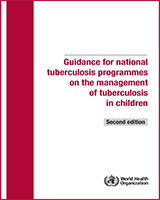Overview
It is estimated that one third of the world’s population is infected with Mycobacterium tuberculosis (the bacterium that causes tuberculosis (TB)), and that each year, about 9 million people develop TB, of whom about 2 million die. Of the 9 million annual TB cases, about 1 million (11%) occur in children (under 15 years of age). Of these childhood cases, 75% occur annually in 22 high-burden countries that together account for 80% of the world’s estimated incident cases.
In countries worldwide, the reported percentage of all TB cases occurring in children varies from 3% to more than 25%. The Stop TB Strategy, which builds on the DOTS strategy developed by the World Health Organization (WHO) and the International Union Against TB and Lung Disease, has a critical role in reducing the worldwide burden of disease and thus in protecting children from infection and disease.
The management of children with TB should be in line with the Stop TB Strategy, taking into consideration the particular epidemiology and clinical presentation of TB in children. These consensus guidelines were produced to help the National Tuberculosis Programmes on the management of tuberculosis in children.
The designations employed and the presentation of the material in this publication do not imply the expression of any opinion whatsoever on the part of the World Health Organization concerning the legal status of any country, territory, city or area or of its authorities, or concerning the delimitation of its frontiers or boundaries. Dotted lines on maps represent approximate border lines for which there may not yet be full agreement.
The mention of specific companies or of certain manufacturers' products does not imply that they are endorsed or recommended by the World Health Organization in preference to others of a similar nature that are not mentioned. Errors and omissions excepted, the names of proprietary products are distinguished by initial capital letters.
All reasonable precautions have been taken by the World Health Organization to verify the information contained in this publication. However, the published material is being distributed without warranty of any kind, either expressed or implied. The responsibility for the interpretation and use of the material lies with the reader. In no event shall the World Health Organization be liable for damages arising from its use.

